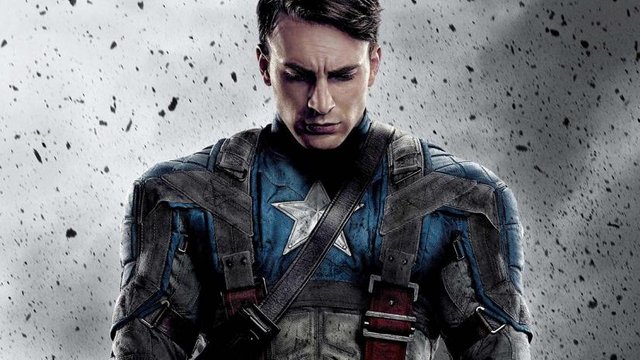
I'm starting my rewatch with Captain America: The First Avenger as the earliest story in the Marvel Cinematic Universe timeline, even though it was the fifth MCU film to be released. For a list of the films I am reviewing in order, see my first post here.
Somebody Get That Kid a Sandwich!
I forgot how scrawny they made Chris Evans look for pre-serum Steve Rodgers. It's all special effects, of course, but it's pretty good special effects. There are a couple moments where it doesn't look quite right – when he's sitting in the car with Agent Carter, for example, the proportions seem a little off, like when Frodo rides in the wagon with Gandalf in The Fellowship of the Ring (though not quite as dramatic). The film plays with a sort of reverse exhibitionism of Little Rodgers, in which we see him with his short off more than we do after he's bulked up (other than the charged moment when Carter almost touches his chest right after the experiment works).
The early part of the movie is setup, but what I like in coming back to it after eight years is how Rodgers has stayed true to his motivations. When going for his fifth try at joining the U.S. Army, Steve tells Dr. Erskine – creator of the super serum – that he doesn't want to kill anyone but is troubled by those who take advantage of others: "I don't like bullies." Later, on the night before the procedure, Dr. Erskine tells him that attitude is why he was chosen, "because a strong man who has power all his life will lose respect for that power, but a weak man knows the value of strength, and knows compassion." Perhaps this is overstating the obvious, but empathy for those who are harassed and protection for those who are oppressed by evil is the core of what makes Captain America a likable superhero, and his adherence to those values comes into play over and over.
OMG It Worked!
Many of the MCU films are origin stories, which is necessary to a degree but also can get tedious to some degree, especially when we get more and more origins to see. Although the first of my reviews, CA:TFA is the third origin story of the MCU,1 which means there is already something of an established pattern, but it's not quite stale yet. There are two aspects of the quintessential coming-to-power moment in CA:TFA that I quite like, the immediate leap into action and the little humorous moments that show his inexperienced eagerness.
Right after the successful serum procedure, a Hydra agent sets off a bomb, killing Dr. Erskine and several others, before running out. Immediately, Rodgers takes off after the Hydra man, saving Agent Carter, running through the streets of New York, and eventually diving into a river and punching through the cockpit of a submarine to drag the bad guy back onto dry land. He simply jumps into action to do the right thing, just like he did during training by jumping on the (fake) grenade.
In addition to further demonstrating the kind of superhero he will become, Rodgers' immediacy of action also sets up the humor, mixed in with some trope bending. Peggy gets angry when Rodgers saves her because he messes up her shot at the Hydra agent, and when Rodgers goes running after the Hydra man's car at full speed, he loses control and flies off balance through a shop window. When the Hydra agent pushes a boy in the river, Rodgers looks like he's about to jump to the kid's rescue, but the boy waves him off saying, "I can swim!"
Of course, the most humorous part of the film is the montage of Captain America as propaganda prop for war bonds, a gig he gets after a newspaper prints a photo of him holding up a car door to shield himself from the Hydra agent's gunfire. (The door has a star emblazoned on it, prefiguring Captain America's iconic shield.) I will have to keep my eyes open when watching the films that precede CA:TFA, but I am pretty sure this is the most self-referential and "meta" an MCU movie gets, at least in Phase 1. The diegetic "Captain America" comic books are just great, and the early uniform design channeling Joe Simon's original sketch of the character has just enough camp to make it work as feel-good agitprop.
In some ways, the sequences (chase scene followed by musical number) work to subvert the traditional origin story trope of testing out all his new powers. Rather than trying to find the limits of his capabilities or even put them to good use, Rogers reverts almost completely to the powerless nothing he was before the serum experiment. Sure, he's helping the war effort through nebulous alliterative slogans like "Bonds Buy Bullets," and at least he's not stuck in a lab, but as Peggy reminds him after watching a group of front-line soldiers mock (bully) him off a stage, there are more options than being a lab rat or a dancing monkey.
Not for the Eyes of Ordinary Men
CA:TFA is the effective introduction of the most prominent MacGuffin in the MCU, the Tesseract, although it technically first appeared in a Thor mid-credits scene as a teaser for the then-forthcoming Avengers film. We learn a bit about the device, such as its provenance as a piece from Odin's collection of magical goodies in Asgard, but its most prominent feature is as an energy source. Johann "Red Skull" Schmidt – played by Hugo "Agent Elrond" Weaving – discovers the Tesseract hidden away in Norway and then proceeds to develop a cadre of energy weapons that seemingly wink people out of existence in a CGI effect now wholly unlike one we'll on a massive scale in about 18 films from now.
What I find most interesting is that despite its conspicuous nature as an object of desire and motivation later in the MCU, the MacGuffinness of the Tesseract in CA:TFA is actually pretty tame. After Schmidt finds it in an early scene, the Tesseract just sort of becomes a piece of the background tech that somehow powers all the new toys Hydra gets to play with. We see it again at the end of the film, most importantly when it falls into the ocean and then is retrieved by Howard Stark. But given how significant the Tesseract (and even more importantly, what it contains) becomes as part of the MCU's overarching storyline across multiple phases, it is a bit surprising that it doesn't get more schrift here. It's just kind of there.
And I don't think this is just a matter of introducing a gadget that is later retconned into something bigger. As mentioned, the Tesseract is specifically introduced at the end of Thor as a tie-in the first Avengers movie. Joss Whedon, who directed both The Avengers and the Thor mid-credits scene, already knew the Tesseract was going to be a big deal, which means that Joe Johnston, Christopher Markus and Stephen McFeely almost certainly knew the Tesseract was going to play a prominent role in The Avengers plot as well. I think it's to their credit that they didn't allow a prop to overshadow Steve Rodgers' character development.
In terms of the Red Skull and Hydra as the bad guys, they work fine for the 1940s as a Nazi faction and proxy. However, I have to admit that I am glad to not be covering the TV shows, because I think the persistence of Hydra gets a little obnoxious and strained, especially in Agents of S.H.I.E.L.D. They are a little flat, but then I think that's okay for this type of story.
Final thoughts
I remember enjoying Captain America: The First Avenger when it came out, and I think it holds up pretty well returning to it. Even after all of the MCU superhero introductions we've seen since 2011, it still feels like a bit of a different take on the origin story genre.
Stay tuned soon for my next review, which will be on the very first MCU movie, Iron Man.
Footnotes
- I count both Iron Man and The Incredible Hulk as origin stories, but not Thor, which is more of a traditional bildungsroman. While an origin story can also be a bildungsroman, I don't think Thor fits the bill of origin story in the way the term is typically used.
| Follow Curtis | Follow Bookdotes |
|---|---|

great
Downvoting a post can decrease pending rewards and make it less visible. Common reasons:
Submit
Congratulations @caweyant! You received a personal award!
You can view your badges on your Steem Board and compare to others on the Steem Ranking
Do not miss the last post from @steemitboard:
Vote for @Steemitboard as a witness to get one more award and increased upvotes!
Downvoting a post can decrease pending rewards and make it less visible. Common reasons:
Submit